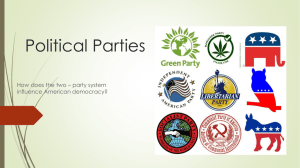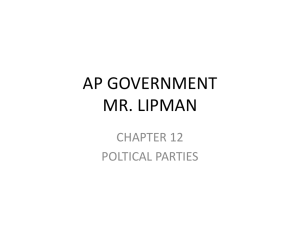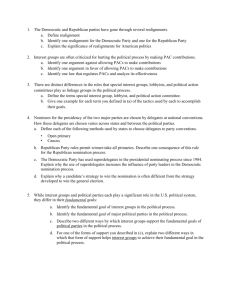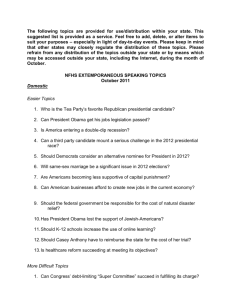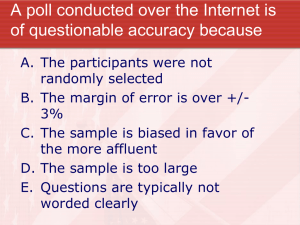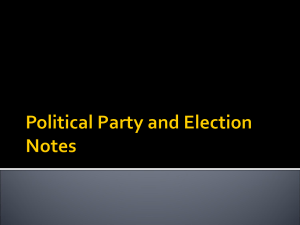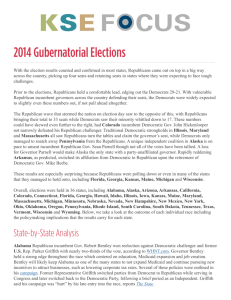Origins of U.S. Political Parties (Overview)
advertisement
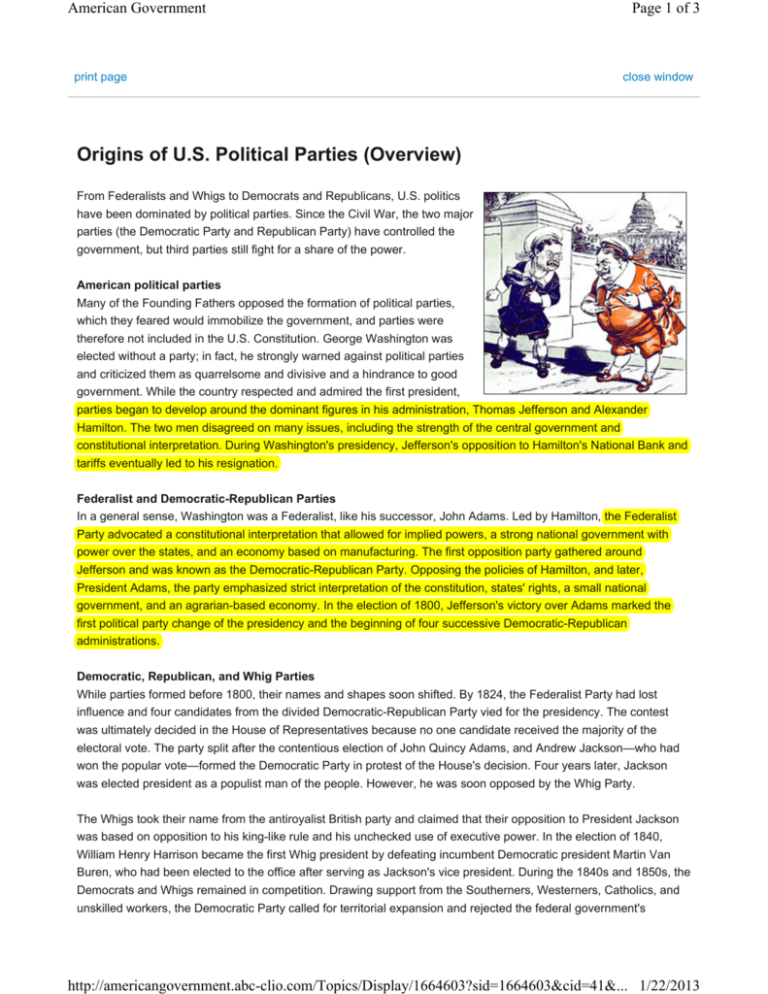
American Government print page Page 1 of 3 close window Origins of U.S. Political Parties (Overview) From Federalists and Whigs to Democrats and Republicans, U.S. politics have been dominated by political parties. Since the Civil War, the two major parties (the Democratic Party and Republican Party) have controlled the government, but third parties still fight for a share of the power. American political parties Many of the Founding Fathers opposed the formation of political parties, which they feared would immobilize the government, and parties were therefore not included in the U.S. Constitution. George Washington was elected without a party; in fact, he strongly warned against political parties and criticized them as quarrelsome and divisive and a hindrance to good government. While the country respected and admired the first president, parties began to develop around the dominant figures in his administration, Thomas Jefferson and Alexander Hamilton. The two men disagreed on many issues, including the strength of the central government and constitutional interpretation. During Washington's presidency, Jefferson's opposition to Hamilton's National Bank and tariffs eventually led to his resignation. Federalist and Democratic-Republican Parties In a general sense, Washington was a Federalist, like his successor, John Adams. Led by Hamilton, the Federalist Party advocated a constitutional interpretation that allowed for implied powers, a strong national government with power over the states, and an economy based on manufacturing. The first opposition party gathered around Jefferson and was known as the Democratic-Republican Party. Opposing the policies of Hamilton, and later, President Adams, the party emphasized strict interpretation of the constitution, states' rights, a small national government, and an agrarian-based economy. In the election of 1800, Jefferson's victory over Adams marked the first political party change of the presidency and the beginning of four successive Democratic-Republican administrations. Democratic, Republican, and Whig Parties While parties formed before 1800, their names and shapes soon shifted. By 1824, the Federalist Party had lost influence and four candidates from the divided Democratic-Republican Party vied for the presidency. The contest was ultimately decided in the House of Representatives because no one candidate received the majority of the electoral vote. The party split after the contentious election of John Quincy Adams, and Andrew Jackson—who had won the popular vote—formed the Democratic Party in protest of the House's decision. Four years later, Jackson was elected president as a populist man of the people. However, he was soon opposed by the Whig Party. The Whigs took their name from the antiroyalist British party and claimed that their opposition to President Jackson was based on opposition to his king-like rule and his unchecked use of executive power. In the election of 1840, William Henry Harrison became the first Whig president by defeating incumbent Democratic president Martin Van Buren, who had been elected to the office after serving as Jackson's vice president. During the 1840s and 1850s, the Democrats and Whigs remained in competition. Drawing support from the Southerners, Westerners, Catholics, and unskilled workers, the Democratic Party called for territorial expansion and rejected the federal government's http://americangovernment.abc-clio.com/Topics/Display/1664603?sid=1664603&cid=41&... 1/22/2013 American Government Page 2 of 3 intrusion in economic and social matters. The Whig Party consisted of Northerners, Midwesterners, skilled workers, manufacturers, and evangelicals; they opposed territorial expansion and advocated the federal government's right to regulate the economy and such social issues as slavery and alcohol use. After the Whig Party collapsed due to internal division over slavery in the Western territories, the Republican Party was formed out of several political factions in 1854. Republicans opposed what they perceived as the growing political power of the South during the 1850s, and their second candidate for president, Abraham Lincoln, won the election of 1860 on the strength of the Northern vote. Republicans continued to dominate politics during the Civil War and imposed harsh Reconstruction policies that angered Southern whites and motivated them to rejoin politics through the Democratic Party, which had largely opposed the war. In the late 19th century, the Republican Party's scandals and associations with big business ran counter to a wave of populism that was more aligned with the Democratic Party's traditional farming, working-class, and immigrant base. Third parties From the 1860s onward, the Democratic and Republican parties have dominated U.S. government. Smaller, socalled third parties arise from time to time, but no independent or third-party candidate has won a presidential election, and very few have won congressional seats. Perhaps the most famous third-party presidential candidate was Theodore Roosevelt in the election of 1912. Roosevelt returned to Washington to run again for president after relinquishing the office to William Howard Taft. Since Taft had the Republican nomination, Roosevelt chose to run as a candidate for the Progressive Party, which he nicknamed the Bull Moose Party. While Roosevelt earned more electoral votes than Taft, he didn't earn as many as Woodrow Wilson, and the White House was handed over to the Democrats. The Libertarian Party, the Reform Party, and the Green Party USA have all tried to compete with the Republican and Democratic parties in more recent presidential elections, to mixed results. While independent candidate Ross Perot captured nearly 20% of the popular vote in the election of 1992, he received less than half of that amount as the Reform Party candidate in the election of 1996. No independent or third-party candidate has won more than 3% of the popular vote since then, though by winning 2.7% of the popular vote in 2000, Green Party candidate Ralph Nader may have affected the outcome of an election that was won by less than 1%. Other countries have different party systems. Democratic countries ranging from Brazil to Israel have varying numbers of parties, some of which make alliances to form governments. Nondemocratic countries typically allow only a single official party. Further Reading Klobuchar, Lisa. Third Parties: Influential Political Alternatives. Minneapolis, MN: Compass Point, 2008; Maisel, L. Sandy, and Charles Bassett. Political Parties and Elections in the United States: An Encyclopedia. New York: Garland Pub., 1991; Starks, Glenn L., and F. Erik Brooks. How Your Government Really Works: A Topical Encyclopedia of the Federal Government. Santa Barbara, CA: Greenwood, 2008. Select Citation Style: MLA MLA "Origins of U.S. Political Parties (Overview)." American Government. ABC-CLIO, 2013. Web. 22 Jan. 2013. Entry ID: 1664603 back to top http://americangovernment.abc-clio.com/Topics/Display/1664603?sid=1664603&cid=41&... 1/22/2013 American Government Page 3 of 3 http://americangovernment.abc-clio.com/Topics/Display/1664603?sid=1664603&cid=41&... 1/22/2013
